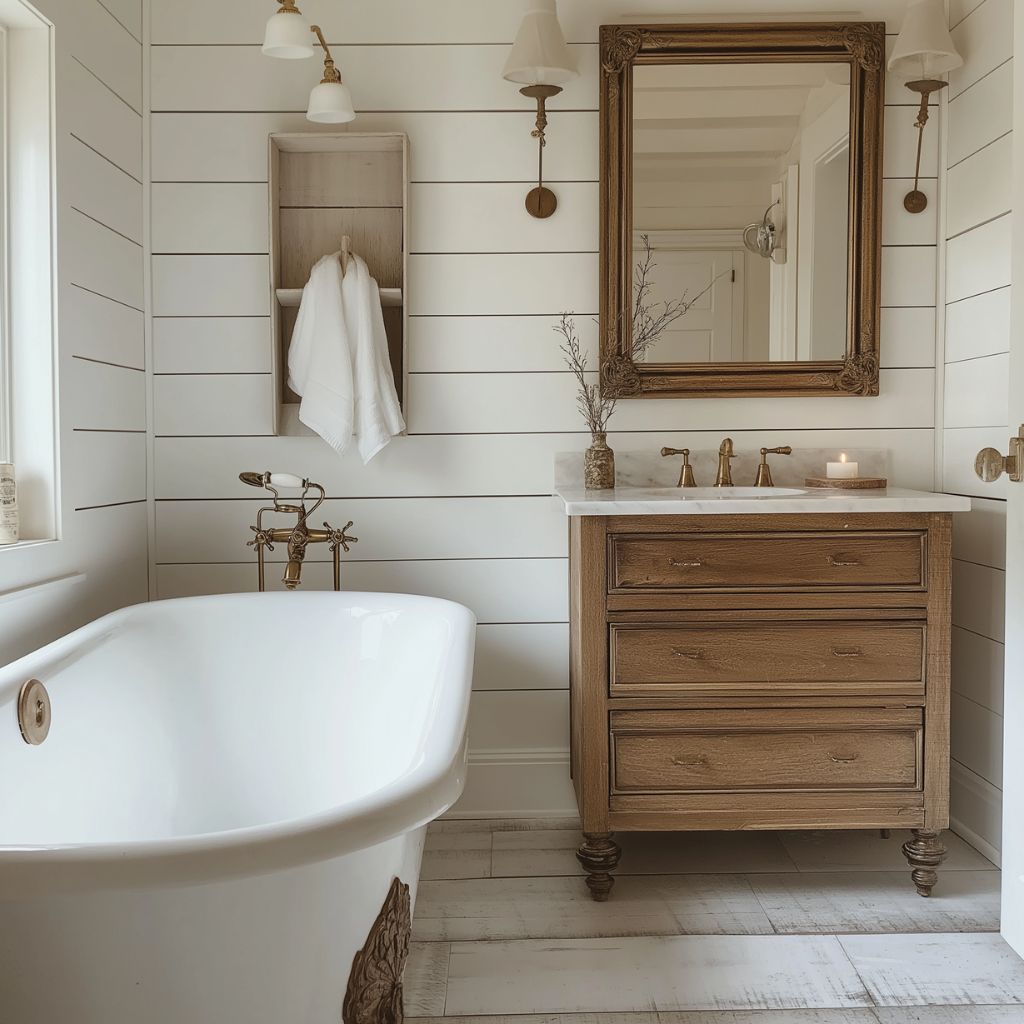Complete Guide to Designing Your Dream Bathroom from Scratch (Layout, Fixtures & Style Tips)
Table of Contents
Introduction
Designing a bathroom from scratch is both a thrilling opportunity and a high-stakes investment. Whether you’re building a new home or renovating a dated space, the bathroom is more than a utilitarian area—it’s a personal retreat.
According to a recent survey by the National Kitchen and Bath Association (NKBA), homeowners are prioritizing comfort and personalization more than ever, with over 60% seeking spa-like bathroom designs in 2024.
From space planning to selecting the right fixtures, tiles, and lighting, every design decision plays a role in creating a bathroom that’s beautiful, functional, and built to last.
In this complete guide, we’ll walk you through everything you need to consider when designing your dream bathroom from the ground up. You’ll get layout advice, material comparisons, lighting strategies, and modern style tips—all tailored to help you make confident, lasting choices.
In-Depth Outline
1. Start with the Right Bathroom Layout
- Assess your available space and plumbing access.
- Decide between single, double, or floating vanities based on functionality.
- Include zoning for wet and dry areas (e.g., shower vs. vanity zone).
Table: Common Bathroom Layout Types
| Layout Type | Ideal For | Key Features |
| Full Bathroom | Family Homes | Bath + Shower + Vanity + Toilet |
| Powder Room | Guest Spaces | Toilet + Small Sink |
| Jack-and-Jill | Shared Bedrooms | Double Vanity, Shared Access |
2. Choosing Fixtures & Fittings Wisely
- Opt for water-efficient fixtures (look for WaterSense label).
- Match faucet finishes with hardware for cohesion.
- Consider wall-mounted or freestanding tubs based on space.
Table: Fixture Style Comparisons
| Fixture | Modern Style | Farmhouse Style |
| Sink Faucet | Matte Black, Minimalist | Brushed Nickel, Cross Handles |
| Bathtub | Freestanding Acrylic | Clawfoot Cast Iron |
3. Selecting the Right Materials
- Use porcelain or ceramic tiles for durability and moisture resistance.
- Quartz or marble for vanities adds elegance and longevity.
- Choose slip-resistant flooring (especially for wet zones).
Table: Best Material Choices by Surface
| Surface | Recommended Material | Notes |
| Floors | Porcelain, Natural Stone | Non-slip texture recommended |
| Vanity Counter | Quartz, Marble | Heat and stain-resistant |
| Shower Walls | Ceramic Tile, Glass Panels | Easy to clean, waterproof |
4. Lighting Design for Ambiance and Function
- Layer lighting: ambient, task, and accent.
- Use sconces or backlit mirrors at face height.
- Include dimmers for spa-like flexibility.
5. Storage Solutions That Maximize Space
- Use vertical storage: medicine cabinets, floating shelves.
- Consider vanity drawers over cabinets for better organization.
- Add built-in niches in the shower for convenience.
Table: Storage Feature Breakdown
| Storage Type | Ideal Location | Benefit |
| Floating Shelves | Above Toilet or Vanity | Open & Airy Storage |
| Built-In Niches | Inside Shower | Holds Toiletries Discreetly |
| Drawer Organizers | Vanity Drawers | Keeps Small Items Tidy |
6. Smart Tech & Sustainability
- Install low-flow showerheads and dual-flush toilets.
- Add underfloor heating for comfort and efficiency.
- Integrate smart mirrors or touchless faucets.
7. Style & Color Palette Inspiration
- Neutral palettes with earthy tones are timeless.
- Use statement tiles or bold wallpaper for character.
- Mix textures—matte finishes, natural wood, and metals.
8. Common Mistakes to Avoid
- Neglecting ventilation (install an exhaust fan!).
- Overlooking lighting placement.
- Choosing style over functionality in high-use areas.
Table: Design Mistakes and Fixes
| Mistake | Solution |
| Poor Ventilation | Install Exhaust Fan with Timer |
| Dim Vanity Lighting | Add Task Sconces at Eye Level |
| No Storage Planning | Include Custom Drawers & Niches |
Detailed Content Expansion
1. Start with the Right Bathroom Layout
The layout is the backbone of any bathroom design. Whether you’re starting from studs or just rearranging fixtures, a well-thought-out layout ensures flow, function, and aesthetic harmony.
Begin by assessing your available square footage and plumbing constraints. Plumbing lines can be costly to move, so where possible, build around existing pipe locations. Next, identify your must-haves—do you need a double vanity? Separate shower and tub? Space for a linen closet?
A practical trick is to divide your bathroom into “wet” and “dry” zones. Wet zones include the shower, tub, and toilet, while dry zones focus on vanities and storage. This zoning not only helps visually but also supports better moisture control.
Table: Common Bathroom Layout Types
| Layout Type | Ideal For | Key Features |
| Full Bathroom | Family Homes | Bath + Shower + Vanity + Toilet |
| Powder Room | Guest Spaces | Toilet + Small Sink |
| Jack-and-Jill | Shared Bedrooms | Double Vanity, Shared Access |
Tips for Success:
- Allow at least 30 inches of walking clearance in front of fixtures.
- Opt for a pocket door in tight spaces to save swing room.
- Align fixtures along one wall to minimize plumbing complexity.
Ultimately, functionality should drive layout. Style can be layered in later—but bad layout is costly to fix post-installation.
3. Selecting the Right Materials
Bathrooms are high-moisture environments, so choosing the right materials is crucial—not just for appearance, but for longevity and safety.
Flooring should be non-slip and water-resistant. Porcelain tiles are a top pick due to their durability and variety of finishes. For a more organic look, natural stone adds texture, but requires sealing.
When it comes to vanity countertops, quartz is a crowd favorite—it resists moisture, is easy to maintain, and mimics natural stone. Marble offers classic elegance but can stain or etch if not properly sealed and maintained.
Shower walls offer more design flexibility. You might opt for large-format ceramic tiles to reduce grout lines, or go luxe with seamless glass panels for a clean, modern finish.
Table: Best Material Choices by Surface
| Surface | Recommended Material | Notes |
| Floors | Porcelain, Natural Stone | Non-slip texture recommended |
| Vanity Counter | Quartz, Marble | Heat and stain-resistant |
| Shower Walls | Ceramic Tile, Glass Panels | Easy to clean, waterproof |
Material Tips:
- Choose matte or honed finishes on flooring to improve grip.
- Always seal natural materials like marble or travertine.
- Stick with mold-resistant grout in wet areas to avoid mildew.
Making smart material choices up front will prevent costly repairs and keep your bathroom looking fresh for years to come.
Conclusion
Designing your dream bathroom from scratch is a rewarding challenge that combines creativity, planning, and practicality. By focusing on efficient layouts, durable materials, thoughtful lighting, and timeless style choices, you can build a space that not only looks stunning but serves your daily needs effortlessly.
Every detail—from the tile beneath your feet to the faucet you turn each morning—should reflect your style while ensuring comfort and durability. With careful planning and smart decisions, your dream bathroom is within reach.

